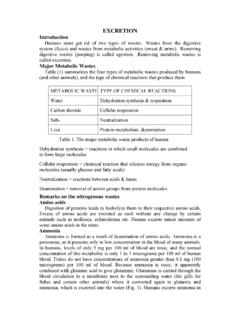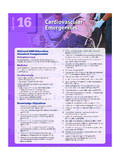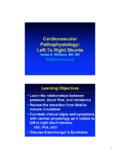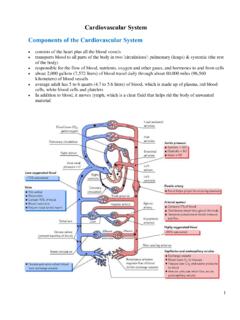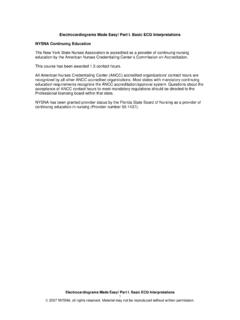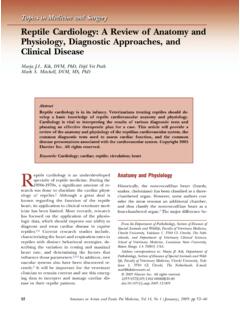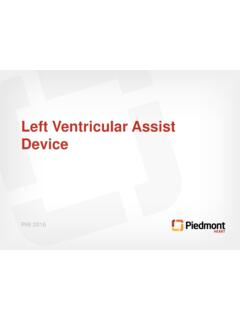Transcription of Cardiovascular system
1 Cardiovascular system 1) The SA node is the normal pacemaker because of its : a) rate of impulse discharge b) location in the atrium c) neural control d) muscular structure e) relative position to the node. 2) The SA node is the normal pace maker because : a) is the most rapidly discharging part b) is the most richly supplied by nerve endings . c) located in the atrium . d) all of the above 3) Regarding the S-A node : a) cells within the S-A node act as heart pace maker because their membrane depolarized to threshold and initiate an action potential . b) acetyl choline increases the slope of the pace - maker potential . c) sympathetic stimulation decreases the slope of the pace - maker potential . d) the pace - maker cells within the S-A node are neurons rather than myocytes . 4) About the cardiac muscle all the following are true except : a) It has low electric resistance of the membrane at the intercalated discs b)It forms true syncytium.
2 C) It obeys the all or none law . d) there is almost a special capillary for each muscle fiber . 5) The cardiac muscle fibers : a) are unstriated muscle fibers b) form true syncytium c) are poor in mitochondria d) have low resistance bridges & tight gap junctions . 6) In the heart , all the following are true except : a) the pericardium limits sudden dilatation of the ventricles b) the left ventricle gives an aid to the right ventricle c) the left atrium is the first part to contract . d) the left side of the intervent . septum is depolarized before the right side . 7) The fibers of the A-V bundle & its branches : a) conduct impulses very slowly b) are highly contractile c) are modified muscle fibers d) are nerve fibers . 8) The cardiac tissue with the slowest rhythmicity is the : a) node without vagal tone b) node with vagal tome . c) ventricular muscle . d) AV node. e) purkinje fibers.
3 9) The action potential of cardiac muscle differs from that of skeletal muscles in: a) it is propagated more slowly . b) it is shorter in duration c) it has a higher amplitude d) it has no plateau . e) all of the above 10) In the heart all the following are true except : a) the right ventricle is thicker than the left ventricle b) the excitation wave cannot spread directly from the atria to the ventricles c) contraction normally begins in the right atrium d) the ventricles contract almost stimultaneously e) the node is the normal pacemaker . 11) When the bundle of His is completely interrupted,the: a) ventricles contract at a rate of 30-40 beats / minutes . b) atria beat irregularly c) QRS complexes vary in shape from beat to beat . d) P-R interval remains constant from beat to beat e) node stops discharging. 12) About the purkinje tissue ,all the following are true except : a) they are modified myocardial cells b) they are confined to the ventricles c) they are primitive nerve tissue d) they conduct impulses as some nerves e) they excite the interventricular septum before the ventricular walls.
4 13) The node : a) but not the node receives a parasympathetic nerve supply b) is connected by a thin band of purkinje fibers to the node c) has a faster rate of diastolic depolarization during vagal activity d) has a faster rate of diastolic depolarization at 39 C than at 37 C. e) is a secondary cardiac pacemaker . 14) The left vent . has a thicker wall than the right ventricle because : a) it is richer in blood supply b) it ejects blood through a narrower orifice c) it ejects a greater cardiac output . d) it ejects blood against a higher pressure e) it contracts at a higher rate . 15) The atrio- ventricular valves : a) have three cusps for each valve b) their closure is initiated when the ventricular pressure exceeds atrial pressure c) open by contraction of papillary muscles . d) none of the above . 16) All the following are correct except : a) the left atrial wall is about the same thickness as the right atrium b) the left ventricle is separated from the left atrium by a bicuspid valve.
5 C) Purkinje system allows the excitation of all ventricular muscle fibers to occur at nearly the same time . d) the right heart receives oxygenated blood from the four pulmonary veins 17) The action potential of the cardiac muscle is characterized by the presence of plateau which: a) in the ventricular muscle it reached 100 m sec b) in the artial muscle, it reached 300 m sec c) it result from a balance between Ca++ influx and K+ efflux . d) it result from an inflow of Cl- and outflow of bicarbonate ions . 18) It is impossible to tetanize a heart because : a) there is a long mechanical refractory period b) the refractory period and the mechanical contractile response are of almost equivalent duration . c) the heart muscles do not contain Ca ++ . d) the mechanical contractile event is usually shorter than the duration of the electrical depolarization . 19) The absolute refractory period in the ventricle : a) increases during sympathetic stimulation.
6 B) coincides with the phase of rapid depolarization and the plateau . c) corresponds with the whole duration of action potential . d) it is shorter than the ARP of skeletal muscle . 20) Under normal conditions , the capillaries : a) contain about 25% of the total blood volume . b) have a very rapid flow rate c) have a higher pressure than that in the arterioles d) are all opened at rest e) contain about 5 % of the total blood volume . 21)About the cardiac conductivity, all the following are true except : a) it is slowest in the A-v node b) it is maximal in the purkinje fibers . c) it is slowest in the ventricular ms. d) it is decreased by vagal stimulation e) it occurs through modified cardiac muscle fibers . 22)About the pacemaker potential, all the following are true except : a) it's amplitude is - 80 to - 90 mv b) it is unstable during rest . c) its slope is decreased by increased permeability to K+.
7 D) the firing level occurs at a potential difference of about - 45 mv . e) repolarization is one slow phase . 23) The main function of the cardiac purkinje system is to : a) prevent premature ventricular beats . b) coordinate the valve movements with myocardial contraction c) enable all parts of the ventricle to contract simultaneously d) delay the systole until the ventricles fill . 24) Propagation of the action potential through the heart is fastest in the : a) SA node b) atrial muscle c) AV node d) purkinje fibers e) ventricular muscle . 25) Myocardial contractility is best correlated with the intracellular concentration of: a) Na+. b) K+. c) Ca++. d) Cl 26) The cardiac muscle is characterized by having all the following except : a) intercalated disk connecting ms. b) A T system located at the Z line c) The same refractory period characteristics as the skeletal ms. d) Acts as a physiological syncytium 27) The greatest percentage of blood volume is found in the : a) Heart b) Aorta c) Distributing arteries and arterioles d) capillaries e) venules and veins Choose whether these statements are true or false : 28 - Cardiac muscle contractility a) depends on an interaction between actin and myosin filaments.
8 B) is enhanced when the serum potassium rises above normal c) is lost if the bathing is made calcium free d) is reduced by the local application of acetylcholine 29 - In the heart , purkinje tissue cells : a) are modified myocardial cells b) are confined to the ventricles c) can conduct impulses as fast as some nerves d) excite the myocardium of the interventricular system before the outer walls of the ventricles. 30 - When the bundle of His is completely interrupted , the : a) ventricles typically contract at about 30 40 beats / min b) atria beat at an irregular rate . c) PR interval on the ECG is longer than normal but remains constant from beat to beat d) QRS complex varies in shape from beat to beat . 31 - Functions of atria : a) blood reservoirs when the venous return accumulates during ventricular systole b) pumping 30 % of venous return into the ventricles during their systole c) atria contains the SAN & AVN.
9 D) atria , specially the right , contain receptors for many cardiac reflexes 32 - Transmission of cardiac impulse occurs through the atria by : a) the right and left atrial mass b) the anterior interatrial band to the left atrium c) the AVB. d) the anterior , middle , and posterior internodal bundles , directly to the AVN . 33- In the heart : a) systolic contraction normally begins in the left atrium b) excitation spreads directly from atrial to ventricular fibres c) atrial and ventricular muscle contracts simultaneously in systole d) the contracting ventricles shorten from apex to base 34- The absolute refractory period in the ventricles : a) is the period when the ventricles are completely inexcitable b) corresponds to the period of ventricular depolarization c) corresponds to the period of ventricular contraction d) is shorter than the corresponding period in artial muscle e) decreases during sympathetic stimulation of the heart 35 - Sinoatrial node cells are.
10 A) found in both atria b) innervated by the vagus c) unable to generate impulses when completely denervated d) connected to AV node by fine bundles of purkinje tissue e) stable with regard to their membrane potentials 36 - The strength of contraction of left ventricular muscle increases when : a) end-diastolic ventricular filling pressure rises b) serum potassium levels rise c) blood calcium levels fall d) strenuous exercise is undertaken e) peripheral resistance is increased 37 - The purkinje tissue cells in the heart : a) conduct impulses faster than some neurons b) are larger than ventricular myocardial cells c) lead to contraction of the base before the apex of the heart d) are responsible for the short duration of the QRS complex e) are responsible for the configuration of the QRS complex . Choose the correct answer: 38. ventricular pressure is higher than the atrial pressure in all phases of the cardiac cycle except in: (A) isometric contraction phase.

